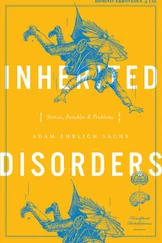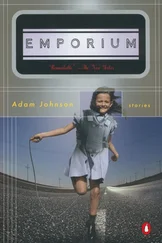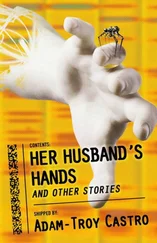“I only ran the prison,” I tell him. “I was an administrator. I staffed the shifts, handled transfers, ordered toilet paper. Safety concerned me, not interrogation. What happened in those cells, I know nothing about. The head of the Stasi was Grünwald — he ran the interrogations. And I would say the Stasi command rather looked down on us administrators — the Stasi had their own dining room and club and sauna. It was they who decided to destroy the records.”
The curator says, “Meaning Grünwald told you to destroy the prisoner files, and your people did it.”
“It took almost a year, yes.”
A girl delivers our cappuccinos. She wears a white T-shirt with epaulettes silk-screened on the shoulders, along with a host of ridiculous medals on the chest and a name tag that reads “Stasi Prison Warden.”
The curator sees the horror on my face. “Yes, I know,” he says. “I wish it weren’t so. But this shirt is the gift shop’s biggest seller, and the memorial is losing money. We charge only modest entrance fees, and the tour guides, they are quite an expense. These people were damaged by their incarceration here, and we are their only means of support. Our plans are big — exhibits, archives — but for now it is about the bottom line, as they say.”
The cappuccino, when I sip, tastes like marzipan.
“Your financial problem is a simple one,” I say. “This is just an abandoned jailhouse. Who would pay to see that?”
“You do not give yourself credit,” the curator says. “This is no ordinary jail. But I take your point. How to get young people interested in the past, that’s the question. Just look at them.” He indicates all the students in the café with us. “Look at how they stare at these phones. That is our biggest competition. On the tours, half of them are updating their Facebook pages, texting their friends, tweeting and so on. Some YouTube the entire tour but never seem to experience it. To think what the Stasi went through to spy on us. Even they couldn’t dream of a world in which citizens voluntarily carried tracking devices, conducted self-surveillance and reported on themselves, morning, noon and night.”
“All this information,” I say. “Yet the world is more mysterious than ever.”
The curator leans forward. “You find the world mysterious ?”
There is a very satisfied look on his face.
I ask, “How can I help you today?”
“Yes, of course,” he says. “Here is my proposal. I think you are the philosophical type, Hans. I believe you are a man of opinions. I propose that you lead a tour of Hohenschönhausen, perhaps for a group of students. We would record this on video and save it as an important document. You could say whatever you like — share information, counter criticisms, shed light. Most important, you would tell the story of this place. When you and I are long gone, a story like this will keep speaking.”
I can’t help smiling. “And who would listen to this tale?”
“Students, scholars, historians. Without the records, stories are all we have.”
Prinz whimpers once, looking up to the biscotti on our saucers.
“You are wrong about me,” I say. “I am no philosopher. And I don’t know any stories.”
Even as I say this, my mind wanders to Gitte, wondering where she is right now and what she’s doing. Is she with her photographer friend? Do they climb mountains of A.A. talk and descend into dark valleys of sober sex?
Prinz whimpers once more.
“Actually, I have a question about dogs,” the curator says. He snaps off a piece of biscotti and holds it above Prinz. “May I?”
I nod. “ Männchen machen, Prinz,” I say.
Prinz rears onto his hind legs, front paws held high.
The curator drops the treat.
Tongue out, Prinz eyes the falling biscotti and snaps it from the air.
“Prinz, is it?” the curator asks. “That’s a good name for a dog.”
“My wife named him. He was a farewell gift to me.”
“I’m sorry to hear that.”
“Hear what?”
“That you and your wife parted.”
I look at little Prinz, oblivious to the problems of the world.
“It is only temporary,” I say.
The curator nods. “Concerning dogs,” he says. “A former inmate told me he found it difficult to sleep because of barking dogs. Yet there is no kennel. Did the prison employ the use of dogs, Hans?”
“The dogs came at night,” I tell him. “A dog handler named Günter, he would bring them in at sunset. He still lives in the neighborhood. Günter was a famous dog trainer at the Stasi academy in Golm. But one day a pack turned on him and attacked him — that’s how he was demoted to prison duty. There were terrible tooth marks on one side of his face, and the wound gave him a lisp. He tried to hide his injuries with a beard. I believe he lost a couple of fingers, too, because he always wore heavy leather gloves. He’d show up at sunset, that angry pack dragging him, and with those enormous gloves, he’d salute. ‘The dogs are quite aggwessive tonight,’ he’d announce. One night, perhaps hoping to rise in our esteem, Günter hid some meat in the tiger cages. There was still a prisoner exercising in the cage when Günter released the dogs, shouting—”
“Please, please,” the curator says. “You must save this story for the video.”
Someone tries to hail the curator on his walkie-talkie, but he mutes it.
“I could go anywhere in the prison?” I ask. “I could say whatever I wished?”
“You would have total freedom,” he says. “Of course, the video would have some contextual material. It would have to tell the viewer what kind of prison this was, what happened here, how many people died and so on. It’s very standard.”
“The death rate in Hohenschönhausen was no different than the national average.”
“I’m sorry, this is not accurate,” the curator says. “The numbers are much higher. They’ve been verified. They are not in dispute.”
I stand and tug on Prinz’s lead. “What took place here wasn’t torture. You have to let go of that. What happened here happened to people’s minds, not their bodies.”
A strange smile crosses the curator’s face. “Please,” he says. “Let’s not end on that note. Let us see if we can find that picture of yours.”
We take our cappuccinos and cross the courtyard, Prinz happy for the new adventure. Making our way to the Administration Complex, we must pass the ridiculous “Memorial Stone” placed in the middle of the exercise yard. The building we enter has metal filing cabinets lining its long corridors. There are hundreds of them, empty. Thousands of inmate dossiers, thousands of confessions, shredded. What did any of it mean, now that nothing remains?
We climb a staircase I’ve climbed countless times, yet I’m still surprised at where it delivers me: the warden’s office. The archivists have prepared it as an exhibit. On the door is a placard in German, English, French and Chinese. It reads: “Office of Warden Hans Bäcker, who for fifteen years ran the prison with exacting precision. Not once was an inmate ever late to a Stasi interrogation or torture session.”
I turn to regard the curator. He only returns my gaze.
I step inside, and a thought strikes me, one I’ve never had before: the room is the exact size and shape of an inmate’s cell. There are other placards, explaining the radios that communicated with the guard towers and the system of flashing lights that kept track of occupied interrogation rooms. The walls are nicotine-stained, except where the archivists have opened three holes in the plaster. Around these holes, they have drawn red circles, one near the radiator, one beside my desk and one on the ceiling. They are labeled Mic1, Mic2 and Mic3. A placard reads: “Not even Warden Bäcker was safe from Stasi surveillance. Three listening devices recorded him at all times. ” I approach a microphone and touch it with a fingertip. My eyes trace its wire until it disappears, headed to wherever it was that Grünwald’s men listened in. My after-school phone calls to Nina. The times Gitte rang up, lonely and guilt-ridden, half sauced in the early afternoon as she confessed to infidelities I didn’t want to hear about.
Читать дальше












